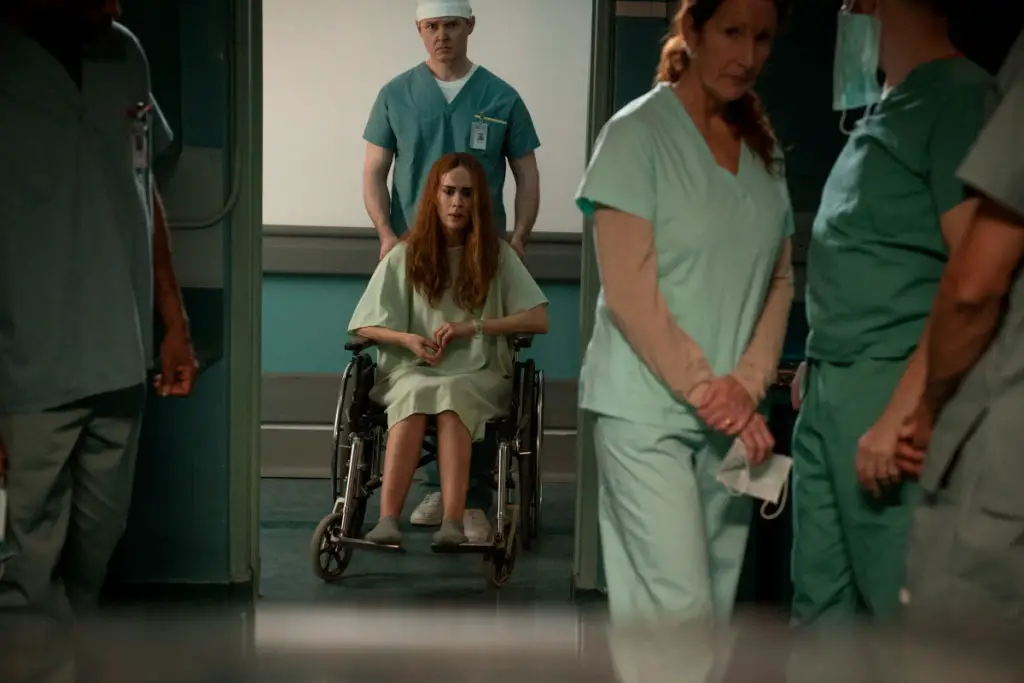Escape from mother’s love: the essence of the film Run (2020). Run: plot summary, meaning of the ending, explanation of the essence.
Country: USA, Canada
Genre: thriller
Year of production: 2020
Directed by: Anish Chaganti
Actors: Kira Allen, Sarah Paulson, Petey Healy, Sara Sohn
tagline: You can’t escape a mother’s love
In recent years, several films and series have appeared dedicated to a specific type of mental disorder called “delegated Munchausen syndrome”. People who suffer from it artificially cause symptoms of some kind of illness in their loved ones in order to satisfy their needs for care, respect from others, etc. Get out”), filmed in the genre of “thriller”, is also about this.
Plot of the film Run
A woman named Diana Sherman has a daughter. The birth was premature – there was a high risk that the child would not survive or remain disabled for life. And indeed, years later, we see a girl named Chloe, chained to a wheelchair. She suffers from a range of illnesses, including arrhythmia, asthma and diabetes. Chloe has to take literally handfuls of pills and stay at home all day. The girl, however, does not waste time: she studies hard and is engaged in her favorite hobby – electronics. Chloe is eagerly waiting for her acceptance letter, but Diana constantly intercepts incoming mail and says that no letters have been received.
 The role of Diana Sherman was played by Sarah Paulson. Frame from the film.
The role of Diana Sherman was played by Sarah Paulson. Frame from the film.
We see how a woman takes care of her daughter, helping her with healing procedures and exercises. However, she clearly has a secret. At night, Diana goes down to the basement and watches a video of little Chloe eating a whole bowl of chocolate dessert. But the use of sugar in such quantities for a girl is probably almost fatal.
One day, Chloe discovers a vial of pills intended for her and a label “trigoxin”, on which, for some reason, the name of Diana. She explains that in fact it is a pasted check. However, later Chloe sees on it that a new label with her name is already pasted on top of the old one. To find an explanation for this, the girl tries to secretly use the Internet on a computer from her mother (she does not have a smartphone and did not have it), but she prudently turned it off. Continuing to look for a clue, the girl also secretly calls a stranger on a landline phone and with his help finds out that the real trigoxin looks completely different.
Under the pretense of going to the movies, Chloe takes Diana into town. Having left during a movie show supposedly in the toilet, the girl rushes to the pharmacy, where she finds out that the real name of the suspicious capsules is ridocaine. This medication is for dogs. The meaning of its use is to weaken the muscles up to immobilization. A shocked Chloe, who has realized the meaning of her mother’s actions, begins an asthma attack. Diana breaks into the pharmacy, injects her with a sedative and takes her home.
Diana tries to come up with an excuse for herself by enlisting the help of a pharmacist and a doctor, but in the end she simply leaves Chloe locked in a room, breaks the telephone wire and disables the elevator needed to move between floors.
 Kira Allen played the role of Chloe Sherman. Frame from the film.
Kira Allen played the role of Chloe Sherman. Frame from the film.
The girl comes up with the idea to use her knowledge in the field of physics. She fills her mouth with water, takes a soldering iron and a blanket connected to the mains via an extension cord, crawls along the roof to the window of the next room, heats the glass with a soldering iron and pours water over it. Glass cracks and breaks. With the help of a blanket, Chloe crawls into the room. As she tumbles down the stairs, Chloe finds herself able to wiggle her toe as the drug she hasn’t taken for a long time stops working.
In a wheelchair, the heroine leaves the house and blocks the path of the mail truck, explains the situation to the postman and asks to take her to the police. But then Diana appears on the road in her car. She injects the postman with a lethal dose of the drug she was carrying in the trunk. Chloe gasps and passes out.
Waking up, the heroine finds herself locked up in the basement of the house. There she finds a letter of admission to the university, as well as documents indicating that Diana is not her real mother. In fact, Diana’s premature daughter died a couple of hours after giving birth. Mad with grief, the woman stole someone else’s healthy child, Chloe, from the hospital. In support of this, in one of the photographs, the girl sees herself at a younger age, standing on both legs. Entered Diana tries to justify herself, wanting to forget about the enmity and start all over again. At the same time, she says that she did everything for the good of her “daughter”. Chloe, furious, replies that all the actions were based on Dina’s selfishness. Hearing this, the latter takes a syringe, fills it with a solvent and moves towards the girl. Chloe manages to lock herself in the closet. There she takes a solution of organophosphate and, unlocking the door, takes it inside.
 Frame from the film.
Frame from the film.
To prevent her “daughter” from dying, Diana is forced to hospitalize her. Having come to her senses and greatly weakened, Chloe uses a note to tell the nurse how dangerous her “mother” is. But Diana manages to distract the staff and kidnap the girl. Fortunately, the nurse who returned and discovered the disappearance makes the correct interpretation of the word “mom” written on paper and calls the guards.
Diana gives Chloe a lift to a broken escalator. In an effort to find another way out of the hospital, the woman finds herself unable to move her wheelchair. It turns out that Chloe is holding her with her foot. Diana asks for a final reconciliation and return home, but the “daughter” rejects her. Seeing the guards, the woman draws a pistol, but immediately takes a bullet and falls down.
At the end of the film, we see Diana seven years after the unfortunate events. She still uses a wheelchair but can now walk with a cane. The girl is being screened at the entrance to the prison to visit Diana there. “Mother” is in the infirmary – we see her on a bed paralyzed. Chloe talks about her success in life. She is happily married, has a daughter, and has a dream job of designing aids for the handicapped. In addition, Chloe met her real parents and communicates with them regularly. At the end of her monologue, the girl takes out a pill hidden in her mouth of the same drug that her “mother” stuffed her with. Judging by the expression on Diana’s face, this is for her. Chloe asks her to open her mouth.
Run Ending explanation
The meaning of the ending of the film Run is quite simple: the former victim and aggressor, that is, Chloe and Diana, have switched places. The latter is now paralyzed and continues to weaken, also due to forced “treatment” with ridocaine tablets. Chloe’s “medicine” is regularly smuggled into the prison under the pretense of dating.
Some in their analysis find a hidden meaning in this episode and offer the following explanations for the ending: the monster “mother” gave birth to the monster “daughter”, the mental disorder of one was transferred to the other, the painful need for care was transferred from Diana to Chloe. However, this contradicts the entire content of the film, where there was not a single hint of something like that. Most of all, what is shown in the Run ending looks like a banal revenge. Chloe simply wants Diana to “be in her shoes”, feel what she has felt for most of her life.
In addition, it is unlikely that the girl would be able to come to prison and bring the drug with the same frequency with which Diana gave it. Perhaps the woman had already received serious and irreparable damage during the clash with the guards. Chloe’s rare visits just sometimes made it possible to aggravate the painful condition.
The meaning of the film Run
So, the authors of the film Run used a real-life mental disorder called “delegated Munchausen syndrome” (in honor of the baron, who, according to legend, was famous for his fictional stories), as a constant danger to the heroine. This is the case in some families. There are even documentaries that are dedicated to a similar situation that ended in tragedy. The trigger for actions to worsen health is not always a disorder, expressed in a painful need for care for the child, support and pity from others. Sometimes the motive is the desire to receive cash benefits and benefits.
 Sarah Paulson as Diana, Pat Healy as Tad. Frame from the film.
Sarah Paulson as Diana, Pat Healy as Tad. Frame from the film.
In reality, however, the picture differs significantly from the almost idyllic relationship of “mother” and “daughter” shown at the beginning of the film Run. Harmful “treatment” suffering from delegated Munchausen syndrome combines with mental manipulation, abusive relationships. To maintain the symptoms of a victim accustomed to helplessness, it does not always make sense for the aggressor to poison.
The description of the relationship between Chloe and Diana resembles a sincere friendship and, it seems, only an accidental disclosure of the truth turns it into a rapidly developing violent confrontation. Such a move can be understood: the authors filmed, by and large, a classic thriller. Dramatic understanding of real relationships with the participation of a mentally ill aggressor and the study of his behavior was not part of their plans.
The essence of the film is to keep the viewer in suspense, forcing them to worry about the heroine. Everything else in the pure thriller genre is secondary. And this goal was accomplished quite well, largely thanks to the excellent performance of the performer of the role of Chloe Kira Allen, who in real life uses a wheelchair.
 Frame from the film.
Frame from the film.
Similar films
- “Dead Mommy” (USA, 2017): the same documentary.
- Gypsy’s Revenge (USA, 2018): another documentary about the same events.
- “Pretense” (USA, 2019): a series with its own look at the events shown in documentaries.
- Love You to Death (USA, 2019): A feature film about the same issue.
- Sharp Objects (USA, 2018): TV series based on Gillian Flynn’s novel about a journalist who travels to her hometown, where she has to remember her childhood traumas.
- “Misery” (USA, 1990): adaptation of Stephen King’s work about a fan of the writer who does not want to part with her idol.







